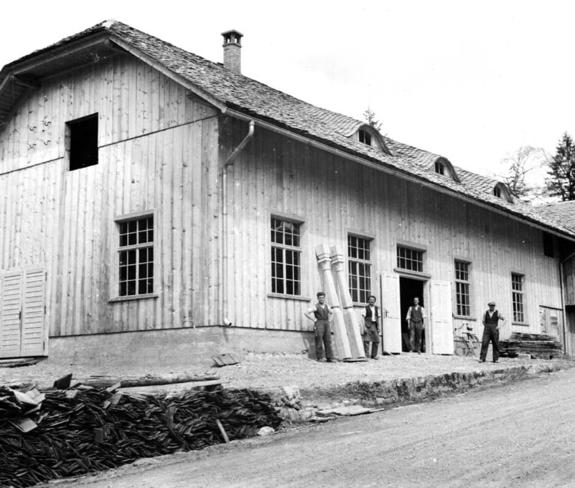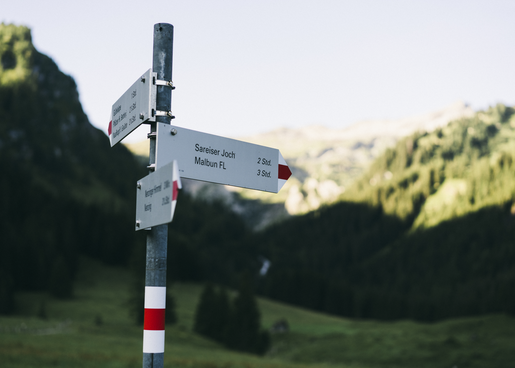Gantner workshop, Arlbergstraße 44
In the middle of the 19th century, a match factory was built on the site of today's workshop. This was the first industrial operation in Wald am Arlberg. "Darthe, Fritz und Compagnie" appear as shareholders of this factory. These were the sons of the Bärenwirt innkeeper Jakob Darthe and their brother-in-law Johann Lorenz Fritz, a well-known businessman in Dalaas. The factory burned down in March 1866, but was subsequently rebuilt. After his business partners moved to Vienna, Fritz sold the factory, which had ceased operations, to Martin Reisch from Frastanz in 1891. He set up a wallpaper factory, as decorating houses with wallpaper was fashionable at the time. The house used to stand on Obere Gasse at the junction towards Radona. It was demolished by Reisch and rebuilt next to the factory. Before the First World War, the property was sold to the Viennese factory owner Viktor Pelz, who, however, remained missing in action during the First World War. The empty building was acquired by master carpenter Josef Frische in the 1920s. He in turn sold it to Felix Gantner, who replaced the factory with a new workshop in 1930 and ran a carpentry business here.
Obere Gasse 26
The house on Annabach is one of the oldest buildings in Wald am Arlberg. A long time ago, a smithy was housed here, which is probably also connected to the field name "Altaness". In the first half of the 19th century, a Schnetzer family lived in this house, who sold it to Mathias Burtscher in 1849. Josef Walch, who came from a large family in Zug, moved in in 1879. It was called "s'Baschtiana" after the father's first name (Sebastian). He moved with his wife and children from Tannberg to Klostertal in the middle of the 19th century. According to oral tradition, the whole family was only able to save themselves through the chimney after an avalanche Several generations of the Walch family have lived in the house since 1879. Three sons of Sebastian Walch - who, as the son of Josef Walch, was given his grandfather's name - died as soldiers in the Second World War.
Obere Gasse 30
This listed house is one of the most important architectural monuments in Wald am Arlberg. The log construction has hardly changed its appearance over the past 100 years. The farm part is offset at the back. A workshop was also located here, as evidenced by the large windows. According to tradition, the brick front of the house was designed by a builder who had worked in France for many years. In the 19th century, one of the many families called Burtscher (the most common name in Wald at the time) lived here. In 1890, the property passed to Alberta Burtscher. She was married to an immigrant from Trentino. Anton Dalberto was from Feltre and had come to the Klostertal during the construction of the Arlbergbahn. The youngest son Andreas took over his parents' property in the course of the 20th century. He died at the end of the 20th century at the age of almost 100 and was one of the originals of the village.
Obere Gasse 25
If village tradition is to be believed, this house is the oldest building in Wald am Arlberg. In the 19th century, it included a dye works, which was located in the immediate vicinity on the Annabach stream. The name "Färbers" therefore became established as the name of the house. It was initially used by the Gantner family who lived here. Through the marriage of their daughter Amalie to Franz Josef Fritz from Schruns, it became part of the Fritz family. The eldest son Karl was a well-known personality in Wald as "Färbers Karle", who was, among other things, the fire department commander for many years and a valued expert on cattle diseases. His brother celebrated his first mass in 1901 and was first curate in Au-Rehmen, later parish priest in Warth and finally parish priest in Raggal for almost three decades.
Rectory, Obere Gasse 17
After the first church in Wald was consecrated in 1728, the inhabitants of the village struggled for almost ten years to find their own priest. The people of Dalaas opposed this request as they feared financial losses. In 1737, the people of Wald were granted the establishment of their own branch of the parish of Dalaas. In 1941, Wald was finally elevated to its own parish. The first clergyman of Wald was Johannes Big, who came from here. He was followed temporarily by Rudolf Lentsch from Montafon and finally Leonhard Josef Jochum, who served as pastor in Wald for 20 years. At the beginning of his tenure, construction of the curacy widum, today's rectory, began in 1739. Johann Purtscher, a master carpenter from Wald, was commissioned to build "four knitted rooms on top of each other". The year 1740 can be seen in the cellar, the year in which the building was apparently completed. Initially, school lessons were also held here until Wald received its own school building in 1783. A total of 14 priests lived in this building until the beginning of the 21st century. The tenures of Johann Josef Fiel (1903 to 1960) and his successor Anton Kegele (1961 until his death in 2013) stand out in particular.
Obere Gasse 13
This mighty building probably had an important function more than 200 years ago, when all traffic was still routed via today's Obere Gasse. This is suggested by the huge cellars. It was not until 1824 that today's main road through Wald was opened as a bypass. In the 19th century, a family by the name of Burtscher lived in this building. To distinguish them from the many other Burtscher families in Wald, they went by the vulgar name "Brazer", which was due to the father's origins. Johann Josef Burtscher (1829-1880) was a carpenter and as such was employed in the construction of wooden bridges throughout southern Germany. He also constructed the spire of the old church in Wald. He also worked there as an organist. In 1855, he married Anna Maria Bachmann (vulgo "Fuchslochers") from Wald. His other wives were Maria Katharina Tschohl from Klösterle and the widow Elisabeth Dachauer, née Tschohl, the founder of the Chapel of the Sorrowful Mary in Danöfen. The descendants of Johann Josef Burtscher moved from Klostertal to Unterland. His great-grandson was the lawyer Hans Laternser, who achieved dubious fame as a defense lawyer at the Nuremberg trials. The former estate of the Burtscher family came into the possession of the Gantner family at the end of the 19th century. Karl Gantner, who was mayor of Dalaas from 1947 until his death in 1954, also set up a shoemaker's workshop here.
Ferien- und Seminarhaus Wald12, Obere Gasse 12
The neighboring property of the Klostertal Museum is known in Wald as "s'Türka Hus", named after the former owner family Türk. It was originally built in 1578 and was given its current appearance in the 19th century. In the middle of the 19th century there were numerous changes of ownership, which indicates the great poverty in the Klostertal at that time. In 1850, the house came into the possession of Franz Josef Schuler, who owned the neighboring estate - today's Klostertal Museum. His grandson Karl Ludwig Thöny sold the smaller house to his brother-in-law Franz Josef Walch. The latter had immigrated with his family from Zug and was called "Eggbua" because of his origins (plot name). After his early death, the house came into the possession of Franz Josef Türk. His father Matthias had moved to the Klostertal from Burgberg in the Allgäu in the mid-19th century and found work as a charcoal burner. After the death of the last occupant, Rosa Thöny, née Türk, the Türk house passed into other ownership. It has been revitalized in recent years and is now used as a vacation and seminar house.
Klostertal Museum
The history of today's Klostertal Museum is very well documented. The original building was erected in 1642 by Kaspar Wachter and has been repeatedly rebuilt over the centuries. It was given its present appearance in 1874 when it was converted from a pair farm to a single farm. The succession of owners was direct until the last occupant Valentin Thöny, the great-great-great-great-great-grandson of Kaspar Wachter. Only the name changed twice through marriage. The Schuler family took over the farm in 1731 and the Thöny family in 1844. Ludwig Josef Anton Thöny, who was responsible for the renovation in 1874, gave the house the name "Ludovikis". Karl Ludwig Thöny took over the estate in 1880. At the end of the 19th century, the family was one of the wealthiest in the Klostertal. The Schuler and Thöny families were well-known moneylenders before the Raiffeisenbank was founded. Karl Thöny's seven years as a prisoner of war during the First World War and the inflation after the war reduced the family's wealth considerably. His sons were orphaned in 1932 after the early death of their parents. Andreas and Valentin Thöny were raised by their aunt Karolina and their uncle Ludwig. Andreas died in 1944 as a soldier in the Second World War. His brother Valentin took over the estate and ran it until 1959. After his foster mother and godmother died, he left the farm and went to Innsbruck to study theology. He was ordained a priest in 1969. His parents' house was converted into the Klostertal Museum in the 1980s and opened as such in 1994.












